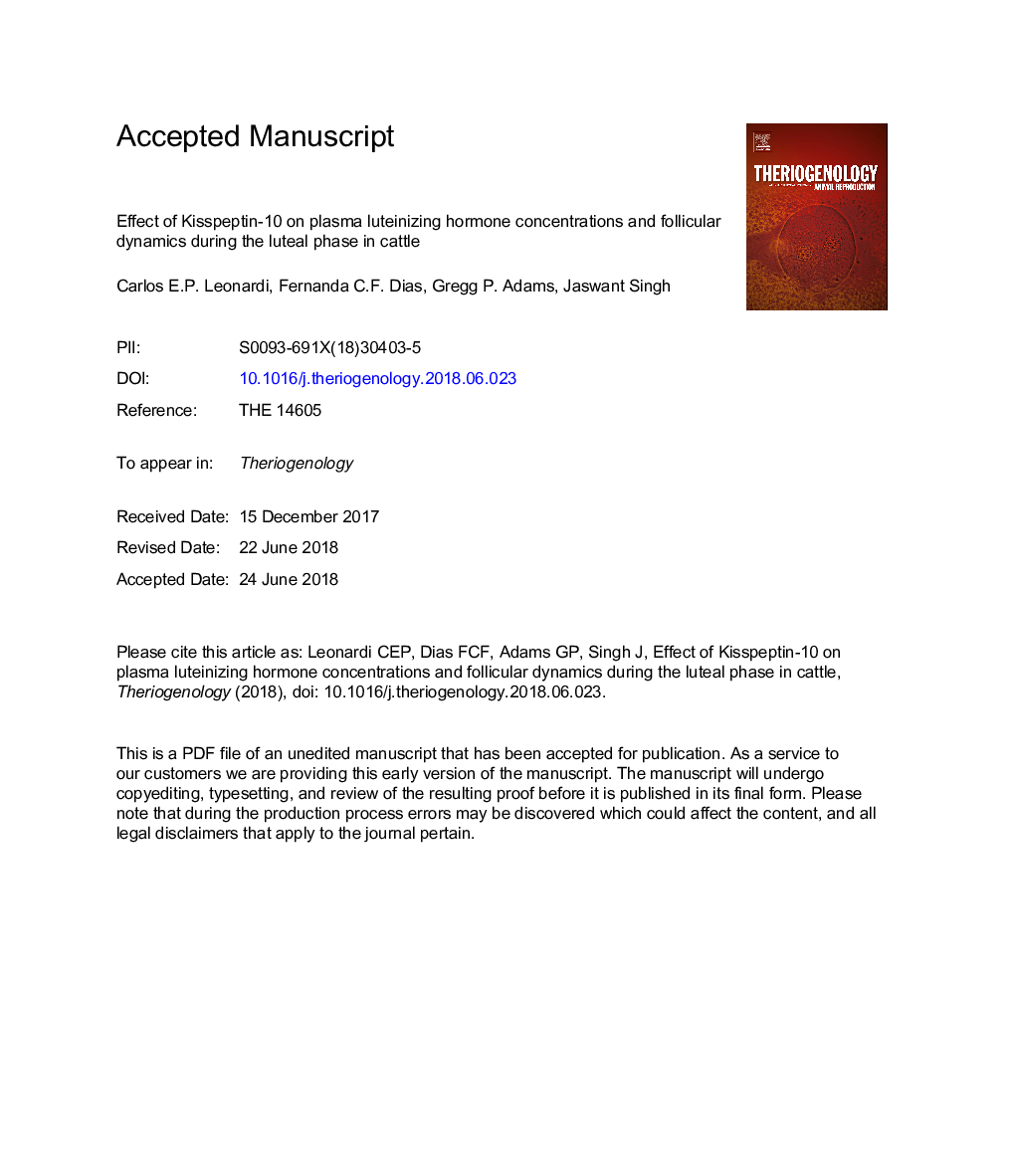| Article ID | Journal | Published Year | Pages | File Type |
|---|---|---|---|---|
| 8426437 | Theriogenology | 2018 | 27 Pages |
Abstract
Two experiments were carried out to determine the effect of Kisspeptin-10 on plasma LH concentrations and follicular dynamics during the luteal phase in cattle. We tested the hypothesis that a single treatment of Kisspeptin-10 will increase plasma LH concentration and the diameter of the dominant follicle, and induce ovulation during the luteal phase of the estrous cycle in cattle. In the Experiment 1, Hereford-cross heifers (nâ¯=â¯28, 14-16â¯mo) were given PGF2α im to induce luteolysis and ovulation. On Day 5 (Day 0â¯=â¯ovulation), a new follicular wave was induced by ultrasound-guided follicular ablation. Heifers were treated on Day 10 (4 days after wave emergence) with 100â¯Î¼g GnRH im (nâ¯=â¯9), 2â¯mL saline im (nâ¯=â¯7), 1â¯mg Kisspeptin-10 im (Kp im, nâ¯=â¯6) or 1â¯mg Kisspeptin-10 iv (Kp iv; nâ¯=â¯6). Blood samples were collected at â60, â15, 0, 5, 15min (0â¯minâ¯=â¯time of injection) and every 15â¯min thereafter until 3â¯h. Transrectal ovarian ultrasonography was performed at 12â¯h intervals from Day 10-14. In Experiment 2, non-lactating beef cows on Day 5 were treated with 100â¯Î¼g GnRH im (nâ¯=â¯9), saline im (nâ¯=â¯5), 10â¯mg of Kisspeptin-10 iv (Kp 10â¯mg; nâ¯=â¯5) or 15â¯mg of Kisspeptin-10 iv (Kp 15â¯mg; nâ¯=â¯5). Blood samples were collected at â15, 0, 15, 30, 60, 120, 180â¯min and twice daily ovarian ultrasonography was done from Day 5-10. In Expt 1, plasma LH concentrations increased for 1â¯h following Kp iv administration. The peak concentration occurred at 15â¯min and was higher in the Kp iv group than in the Kp im group (Pâ¯=â¯0.01). The LH peak was 3.5-folds higher in the GnRH group than the Kp iv group (Pâ¯<â¯0.0001). In Expt 2, GnRH induced higher (Pâ¯<â¯0.001) plasma LH concentrations for all time-points than other groups. Kp 15â¯mgâ¯at peak (15min), 30 and 60â¯min induced higher (Pâ¯<â¯0.0001) plasma LH concentrations than Kp 10â¯mg and saline. Kisspeptin-treated animals did not ovulate in either experiment while GnRH induced ovulation (nâ¯=â¯5/9 in Expt 1; 9/9 in Expt 2). The diameter of the dominant follicle was greater (Pâ¯=â¯0.02) at 12-48â¯h after kisspeptin treatment (Kp groups combined) than the Saline group in Expt 2. In conclusion, Kisspeptin-10 increased plasma LH concentrations and follicle size, and although plasma LH concentrations were higher after iv than im administration, but at the doses used, Kisspeptin-10 did not induce ovulation during the luteal phase in cattle.
Keywords
Related Topics
Life Sciences
Agricultural and Biological Sciences
Animal Science and Zoology
Authors
Carlos E.P. Leonardi, Fernanda C.F. Dias, Gregg P. Adams, Jaswant Singh,
